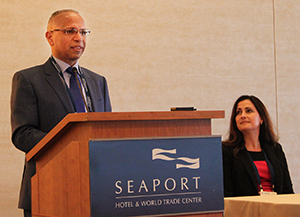
Safwat Sharobeem, M.D., discusses life in private practice as Annemarie Thompson, M.D., listens.
Medical students and residents got a realistic glimpse of the triumphs and challenges of an anesthesiologist in private versus academic practice Saturday during “A Day in the Life of a Physician Anesthesiologist.” The contrast is stark.
Speakers Safwat Sharobeem, M.D., an anesthesiologist with Resurrection Medical Center in Chicago, and Annemarie Thompson, M.D., Director of the Residency Program and Professor of Anesthesiology at Duke University School of Medicine, gave students and residents a peek into the future
‘Don’t be a locker slammer’
“In private practice, you’ll be working on your own,” Dr. Sharobeem said. “You’ll get to the hospital early, check your room, equipment and medications, and see your patient to discuss and start executing your plan. If a regional block needs to be given, you’ll want to do it before the scheduled case time.”
Life in private practice can be routine. But Dr. Sharobeem urged attendees not to be “a locker slammer — someone who comes to the hospital, does their cases, then runs home. That’s not the way it should be.”
Instead, Dr. Sharobeem recommended finding ways to increase efficiency. Just a few minutes shaved off induction or emergence per patient can translate to an hour or more of time daily, which means more cases and more revenue. “But never compromise patient safety for efficiency,” he cautioned.
As an anesthesiologist in private practice, you’ll likely also be the only anesthesiologist at the hospital when you’re on call. “You’ll be the only airway expert,” Dr. Sharobeem said. Because the responsibility lies with you, you should have a plan A, B and C ready. You’ll want to line up all the equipment and medications you’re likely to need because you might not have the personnel to help you.
Because most private practices are small groups, be prepared to handle a variety of cases, too. “Generalists are needed more than specialists,” he said.
Your pay structure can vary because it’s tied to your workload. “The more cases you do, the more money you’ll make,” Dr. Sharobeem said. You can take as much vacation time as you want, too — from four to 24 weeks. The downside? It will be unpaid vacation time. But traveling to educational sessions for CME hours can double as a working vacation. You also may need to obtain your own insurance coverage.
You’ll likely work in a small community hospital where everyone knows each other. Nurses will call you by name. “Everything you do in the hospital is known. Nurses give you feedback, such as, ‘I took care of your patients. They were so happy with you.’”
If you decide to go the private practice route, broaden your scope by trying to move into administration. In these cost-conscious times, increase your value to the hospital by getting an M.B.A. or joining committees that may be related to anesthesiology, or not.
“Show the hospital you’re committed to patient care,” Dr. Sharobeem said.
‘This is a profession, not a job’
Life as an anesthesiologist in an academic medical center has its own set of challenges. Due to the size of the institution, you can end up feeling like “you’re wandering among the masses,” Dr. Thompson said. “But doing a subspecialty can help you find your tribe.”
Finding work-life balance can be tricky, too.
“In an academic practice, you can fill your entire life just doing all the things required of you,” she said. “Your patients may be asleep much of the time but you have to be there with them.”
In her clinical duties, Dr. Thompson works in two cardiothoracic operating rooms and has been known to work 90 hours per week.
“It can be difficult to find time for family, friends and colleagues,” she said. “There will be weeks when you’ll spend more time with your colleagues than your own family.”
Still, Dr. Thompson emphasized that it’s important to find time for outside activities to sustain your career and your sense of well-being. Despite having to make personal-time sacrifices, life as an anesthesiologist in an academic medical center can be fulfilling, especially if you work with people you like.
“It requires lots of problem-solving. You have to like variety and be comfortable with chaos,” she said.
It also can offer job security.
Return to Archive Index